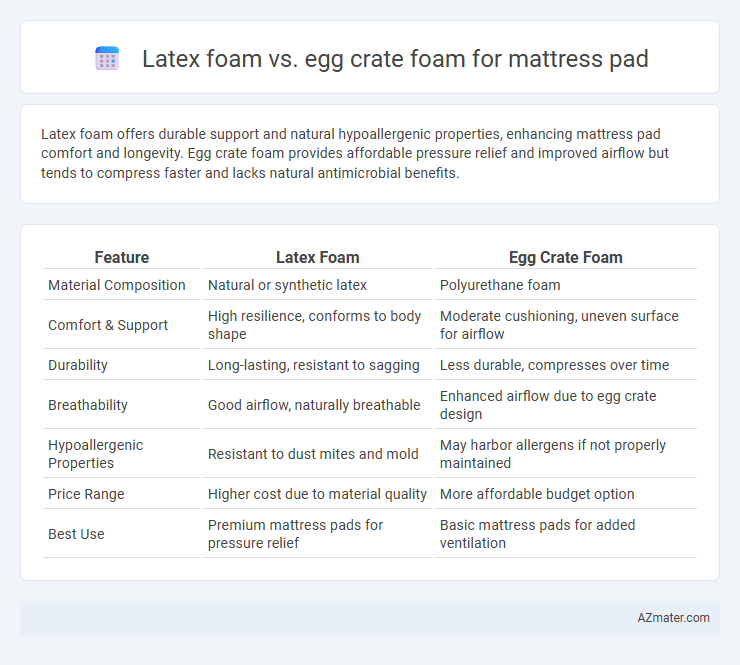Latex foam offers durable support and natural hypoallergenic properties, enhancing mattress pad comfort and longevity. Egg crate foam provides affordable pressure relief and improved airflow but tends to compress faster and lacks natural antimicrobial benefits.
Table of Comparison
| Feature | Latex Foam | Egg Crate Foam |
|---|---|---|
| Material Composition | Natural or synthetic latex | Polyurethane foam |
| Comfort & Support | High resilience, conforms to body shape | Moderate cushioning, uneven surface for airflow |
| Durability | Long-lasting, resistant to sagging | Less durable, compresses over time |
| Breathability | Good airflow, naturally breathable | Enhanced airflow due to egg crate design |
| Hypoallergenic Properties | Resistant to dust mites and mold | May harbor allergens if not properly maintained |
| Price Range | Higher cost due to material quality | More affordable budget option |
| Best Use | Premium mattress pads for pressure relief | Basic mattress pads for added ventilation |
Introduction to Mattress Pad Materials
Latex foam offers superior durability, natural antimicrobial properties, and responsive support ideal for mattress pads, while egg crate foam provides cost-effective cushioning with enhanced airflow and pressure relief. Latex foam typically consists of natural or synthetic rubber, delivering resilience and hypoallergenic benefits, whereas egg crate foam is made from polyurethane foam shaped into peaks and valleys to promote ventilation. Choosing between these materials depends on priorities such as long-term comfort, breathability, and budget constraints.
What is Latex Foam?
Latex foam is a resilient, natural or synthetic material derived from the sap of rubber trees, known for its durability and excellent support in mattress pads. It offers superior breathability and hypoallergenic properties, providing pressure relief and conforming to body contours better than egg crate foam. Latex foam also resists dust mites and mold, making it a preferred choice for allergy sufferers seeking long-lasting comfort.
What is Egg Crate Foam?
Egg crate foam is a type of polyurethane foam designed with a distinctive egg carton-like pattern, which enhances airflow and provides targeted pressure relief by distributing body weight evenly. Unlike latex foam, which is natural or synthetic rubber-based and known for its durability and responsiveness, egg crate foam offers a lightweight and cost-effective option for mattress pads aiming to improve ventilation and reduce heat buildup. Its convoluted surface helps prevent moisture accumulation, making it a popular choice for users seeking affordable comfort and improved mattress protection.
Comfort and Support Comparison
Latex foam offers superior support and durability with its resilient, contouring properties that evenly distribute body weight, reducing pressure points and enhancing spinal alignment. Egg crate foam provides moderate comfort by increasing airflow and cushioning surface contact but tends to compress faster, leading to less consistent support over time. For mattress pads, latex foam is often preferred for long-term comfort and support, while egg crate foam serves well as a budget-friendly option for temporary relief and ventilation.
Durability and Longevity
Latex foam offers superior durability and longevity compared to egg crate foam due to its natural resilience and ability to maintain shape over time. Egg crate foam, typically made from polyurethane, tends to compress and deteriorate faster under regular use, reducing mattress pad support and comfort. Investing in latex foam enhances mattress pad lifespan and sustained comfort through its high-density structure and resistance to sagging.
Breathability and Temperature Regulation
Latex foam offers superior breathability and temperature regulation due to its open-cell structure and natural ventilation channels, which promote airflow and reduce heat retention. Egg crate foam, designed with a convoluted surface, enhances airflow compared to flat foam but often lacks the consistent temperature regulation found in latex. For sleepers prioritizing cooling and moisture-wicking properties, latex foam mattress pads provide a more effective solution in maintaining a comfortable sleep environment.
Allergy Concerns and Hypoallergenic Properties
Latex foam mattress pads are naturally resistant to dust mites, mold, and mildew, making them an excellent choice for allergy sufferers due to their hypoallergenic properties. Egg crate foam, while affordable and providing pressure relief, tends to retain moisture and harbor allergens, which can exacerbate allergic reactions over time. Selecting latex foam helps minimize allergy concerns by offering a cleaner, less allergenic sleeping surface.
Maintenance and Ease of Cleaning
Latex foam mattress pads resist dust mites and mold due to their dense, non-porous structure, requiring minimal cleaning and simple spot treatments with mild soap and water. Egg crate foam, characterized by its open-cell design, tends to trap dust and moisture, necessitating more frequent vacuuming and occasional deep cleaning to prevent odor and allergens. Latex foam's durability makes it easier to maintain over time, while egg crate foam often requires replacement sooner due to wear and difficulty in thorough cleaning.
Price and Value Comparison
Latex foam mattress pads offer higher durability and superior pressure relief compared to egg crate foam, typically costing between $100 and $300 depending on thickness and brand. Egg crate foam is more affordable, usually priced under $50, but provides less support and tends to wear out faster, reducing long-term value. Consumers seeking a balance between cost and comfort often find latex foam to be a better investment despite the higher initial price.
Which Mattress Pad is Best for You?
Latex foam mattress pads offer durable support, excellent breathability, and natural hypoallergenic properties, making them ideal for individuals seeking firmness and temperature regulation. Egg crate foam mattress pads provide uneven surface cushioning that enhances airflow and pressure relief, suitable for those needing softer pressure distribution and budget-friendly options. Choosing the best mattress pad depends on your sleep preferences, whether you prioritize contouring support or increased ventilation and softness.

Infographic: Latex foam vs Egg crate foam for Mattress Pad
 azmater.com
azmater.com